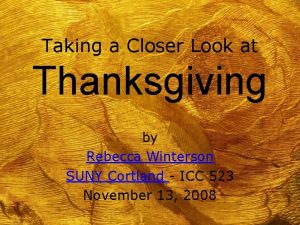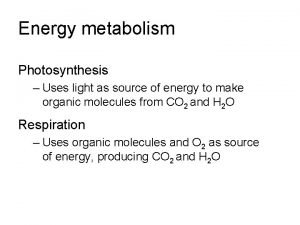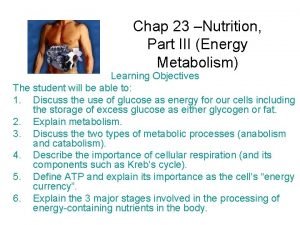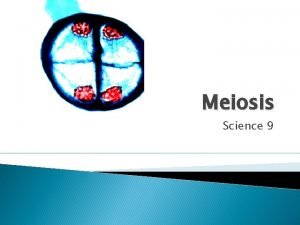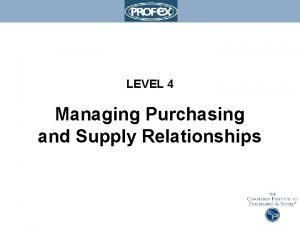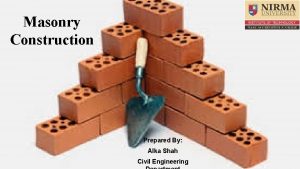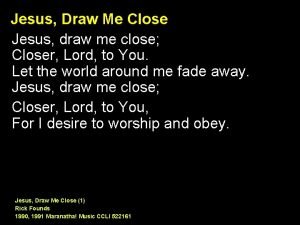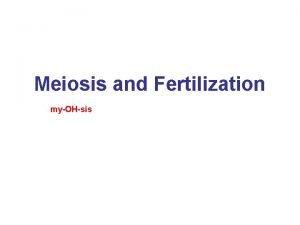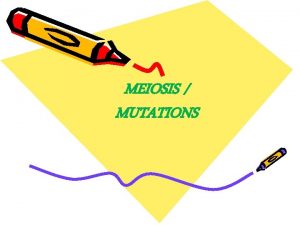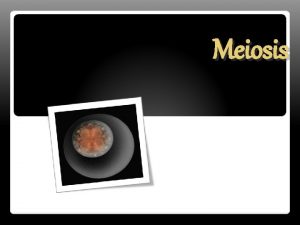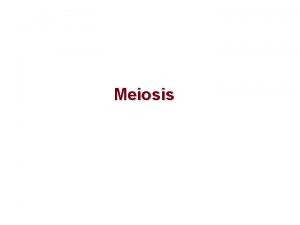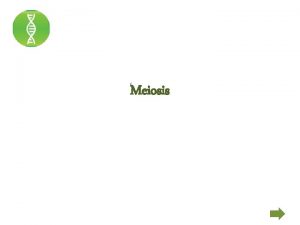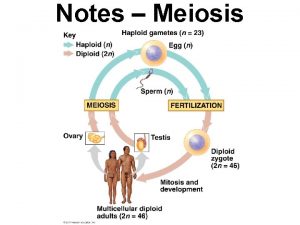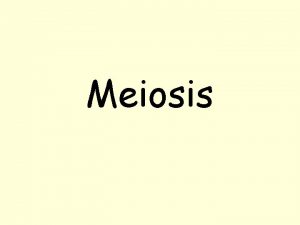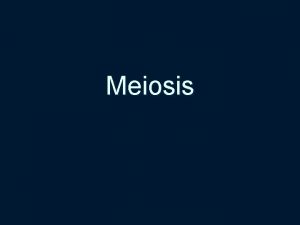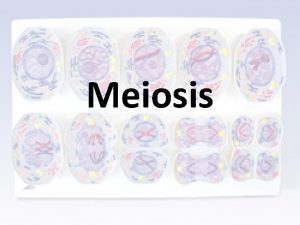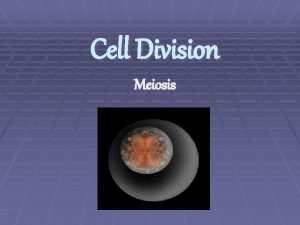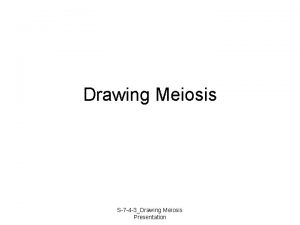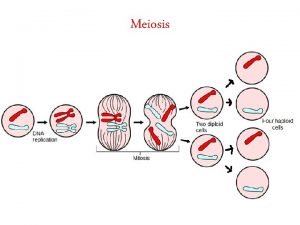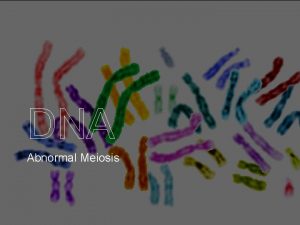Meiosis Science 9 A Closer look at our

































- Slides: 33

Meiosis Science 9

A Closer look at our Chromosomes � If you observe the chromosomes in a body cell through a microscope, you will see that our 46 chromosomes are arranged into 23 pairs that resemble each other in shape and size � These “matching” pairs of chromosomes are known as homologous pairs. � You receive one pair from your mother and one pair from your father.

Chromosomes cont’d. . . � Human body cells have 46 chromosomes � These cells are referred to as diploid, (“di” means double) � The human diploid number is 46 (2 x 23) � Human gametes have 23 chromosomes and are called haploid. (Think half the diploid number)

Reason for Meiosis cont’d. . . � In order for the human chromosome number to remain at 46, gametes must have one half of the chromosomes. � Only haploid gametes can combine during fertilization to form a diploid zygote. � Only a diploid zygote can function as the offspring’s first body cell.

Reason for Meiosis cont’d. . . � You know mitosis ensures that chromosome number does not change � The process that ensures each gamete contains only one-half set of chromosomes is called Meiosis

The process of Meiosis � Meiosis also ensures that each gamete has a different combination of the chromosomes that were present before meiosis � It is these non-identical nuclei that give the gametes the potential to produce offspring different from their parents. � How are some of the chromosomes different?

Crossing over � During the early part of meiosis , double stranded chromosomes come together. � During this time, an event called crossing over can occur � Crossing over is when the chromosomes that are close together actually exchange genetic information.

Crossing over

Now for Meiosis � The word meiosis comes from the Greek word “meioo”, meaning to lessen or reduce

Prophase 1 � Virtually identical to prophase in mitosis, involving the appearance of the chromosomes, the development of the spindle fibers, and the breakdown of the nuclear membrane (envelope). � This is where the homologous chromosomes pair up.

Meiosis I: Prophase I � Double stranded chromosomes match up to make homologous pairs.

Meiosis I: Prophase I � Microscope image:

Metaphase 1 � Here is where the critical difference occurs between Metaphase 1 in meiosis and metaphase in mitosis. � In mitosis, all the chromosomes line up on the metaphase plate in no particular order. � In metaphase 1, the chromosomes pairs (homologous pairs) are aligned on either side of the metaphase plate. � It is during this alignment that crossing over may occur in which pieces of DNA are exchanged.

Meiosis I: Metaphase I � The homologous pairs of double stranded chromosomes line up across the middle of the cell.

Meiosis I: Metaphase I � Microscope image:

Meiosis I: Anaphase I � The homologous pairs of double stranded chromosomes are pulled apart and move to opposite ends of the cell.

Meiosis I: Anaphase I � Microscope image:

Meiosis I: Telophase I � Two nuclei are formed each nucleus has one double stranded chromosome from the homologous pair. We end up with two daughter cells.

Meiosis I: Telophase I � Microscope image:

Prophase 2 �A new set of spindle fibers forms and the chromosomes begin to move toward the equator of the cell.

Meiosis II : Prophase II � Each cell has a set of double stranded chromosomes.

Meiosis II : Prophase II � Microscope image:

Meiosis II : Metaphase II � The double stranded chromosomes line up across the middle of the cell.

Meiosis II : Metaphase II � Microscope image:

Meiosis II : Anaphase II � The double stranded chromosomes are pulled apart at the centromere and move as single chromosomes to opposite ends of the cell.

Meiosis II : Anaphase II � Microscope image:

Meiosis II : Telophase II � Each of the two original cells splits into 2 cells leaving a total of four cells. Each new cell contains a half as many chromosomes as the original cell. They are haploid cells.

Meiosis II : Telophase II � Microscope image:

Where does meiosis occur? � Sexually reproducing animals produce gametes in reproductive organs called gonads. � The formation of gametes in males occurs in the testes (spermatocytes). The gametes formed are called sperm � The formation of gametes in females occurs in the ovaries (oocytes). The gametes formed are called eggs

Meiosis cont’d. . . � Although the process of meiosis is the same in males and females, the final outcome differs. � In males the process of meiosis produces 4 sperm cells. � However in females the process of meiosis produces only 1 egg cell along with 3 polar bodies.

Meiosis in males

Meiosis in females

Questions � On page 50 in your text book work on: ◦ # 1, 2, 3, 4, and 5
 Look to the left look to the right
Look to the left look to the right A closer look at thanksgiving
A closer look at thanksgiving Look closer see me
Look closer see me Ch 7 a closer look: energy metabolism pathways
Ch 7 a closer look: energy metabolism pathways Chapter 7 a closer look energy metabolism pathways
Chapter 7 a closer look energy metabolism pathways Telophase ii
Telophase ii Kelly reidell
Kelly reidell Meisis 1 and 2
Meisis 1 and 2 Crossing over occurs during
Crossing over occurs during Difference between meiosis 1 and 2
Difference between meiosis 1 and 2 Chapter 10 section 1: meiosis
Chapter 10 section 1: meiosis Chapter 10 section 1: meiosis
Chapter 10 section 1: meiosis Prohase 2
Prohase 2 What is your favourite subject in college and why
What is your favourite subject in college and why One day closer quotes
One day closer quotes Closer tactical relationship in procurement
Closer tactical relationship in procurement God is closer than you think
God is closer than you think Double flemish bond in brick masonry
Double flemish bond in brick masonry In alternators the welding current is produced on the
In alternators the welding current is produced on the Sentence
Sentence Care closer to home
Care closer to home Care closer to home
Care closer to home Care closer to home
Care closer to home Cramped joint in stone masonry
Cramped joint in stone masonry Creeping closer meaning
Creeping closer meaning Lexair collet closer
Lexair collet closer Friend that sticks closer than a brother esv
Friend that sticks closer than a brother esv Jesus is my rock and he rolls my blues away lyrics
Jesus is my rock and he rolls my blues away lyrics Activity 4 look at the pictures
Activity 4 look at the pictures 1 look at the picture
1 look at the picture Look at activity 1 and write
Look at activity 1 and write Look how our partners rapt
Look how our partners rapt Elements of design
Elements of design Kesler science answer key
Kesler science answer key

